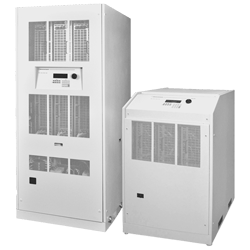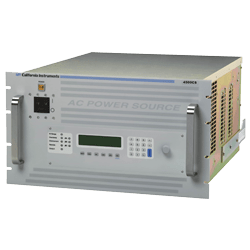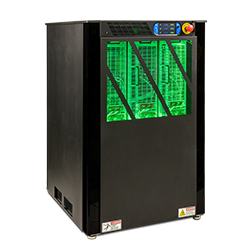High Power AC Source
Programmable AC power for frequency conversion and product test applications
Expandable Power Levels
Available output power of 30, 45, 75 and 90 kVA per unit and multi-unit configurations for power requirements up to 180 kVA and above
Remote Control
Standard RS232, USB and IEEE-488 (GPIB) and optional LAN interfaces are available for automated test applications.
Simple Operation
The BPS Series can be operated completely from its menu driven front panel controller. A backlit LCD display shows menus, setup data, and read-back measurements. IEEE-488, RS232C, USB and LAN remote control interfaces and instrument drivers for popular ATE programming environments are available. This allows the BPS Series to be easily integrated into an automated test system.
Configurations
The BPS is capable of delivering 30, 45, 75, 90, 150 or 180kVA of AC power. The 30 and 45kVA models come as dedicated single or three phase output while the 75, 90, 150 and 180kVA models are dedicated three phase. For higher power requirements, simply parallel the BPS in multi-cabinet configuration. Multi cabinet systems always operate in three phase output mode commonly found in power systems.
Product Evaluation and Test
Increasingly, manufacturers of high power equipment and appliances are required to fully evaluate and test their products over a wide range of input line conditions. The built-in output transient generation and read-back measurement capability of the BPS Series offers the convenience of a powerful, and easy to use, integrated test system.
Avionics
With an output frequency range to 819 Hz, the BPS Series is well suited for aerospace applications. Precise frequency control and accurate load regulation are key requirements in these applications. The available remote control interfaces and SCPI command language provide for easy integration into existing ATE systems. The BPS Series eliminates the need for several additional pieces of test equipment, saving cost and space. Instrument drivers for popular programming environments such as National Instruments LabView™ are available to speed up system integration.
Choice of voltage ranges
Standard voltage ranges are 150V L-N (259V L-L) and 300V (519V L-L) and are direct coupled output. For applications requiring more than 300V L-N (or 519V L-L), the new -333 option provides a dual-range 166 VAC L-N / 333 VAC L-N amplifier output. This new option enables testing of high voltage 480 VAC L-N products at 120% of nominal (576 VAC L-N) as required by IEEE 1547 (Table 1) “Interconnection system response to abnormal voltages”. The optional -HV output transformer provides a third additional 400V L-N and 693 V L-L output range which is internal to the AC chassis. No external magnetics modules are required.
Multi-Box Configurations
For high power applications, two BPS75 or BS90 chassis can be combined to provide 150kVA or 180kVA of output power. For higher power requirement please contact sales for custom configurations.
Simple transition from R&D to Manufacturing.
The California Instruments Mx and RS Series are high performance, feature rich Research and Development solutions. That level of advanced performance is not always required in production and lab environments. Since the BPS shares common code structure and performance characteristics as the Mx and RS the BPS is ideally suited to easily transition into cost effective production solutions.
High Crest Factor
With a crest factor of up to 4.5, the BPS Series AC source can drive difficult nonlinear loads with ease. Since many modern products use switching power supplies, they have a tendency to pull high repetitive peak currents.
Remote Control
Standard RS232, USB and IEEE 488 (GPIB) along with optional LAN remote control interfaces allow programming of all instrument functions from an external computer. The popular SCPI command protocol is used for programming.
BPS Series – AC Transient Generation
The BPS Series controller has a powerful AC transient generation system that allows complex sequences of voltage and frequency to be generated. This further enhances the BPS’s capability to simulate AC line conditions and disturbances. Transient generation is controlled independently yet time synchronized on all three phases. Accurate phase angle control and synchronized transient list execution provide unparalleled accuracy in positioning AC output events.
Transient programming is easily accomplished from the front panel where clearly laid out menu’s guide the user through the transient definition process.
The front panel provides a convenient listing of the programmed transient sequence and allows for transient execution Start, Stop, Abort and Resume operations. User defined transient sequences can be saved to non-volatile memory for instant recall and execution at a later time. The included Graphical User Interface program supports transient definitions using a spreadsheet-like data entry grid. A library of frequently used transient programs can be created and saved using this GUI program.
BPS Series – Measurement and Analysis
The BPS Series is much more than a programmable AC power source. It also incorporates an advanced digital signal processor based data acquisition system that continuously monitors all AC source and load parameters. This data acquisition system forms the basis for all measurement and analysis functions. These functions are accessible from the front panel and the remote control interface for the BPS Series.
Conventional Measurements
Common AC measurement parameters are automatically provided by the data acquisition system. These values are displayed in numeric form on the front panel LCD display. The following measurements are available: Frequency, Vrms, Irms, Ipk, Crest Factor, Real Power (Watts), Apparent Power (VA) and Power Factor.
Waveform Acquisition
The measurement system is based on real-time digitization of the voltage and current waveforms using a 4K deep sample buffer. This time domain information provides detailed information on both voltage and current Waveshapes. Waveform acquisitions can be triggered at a specific phase angle or from a transient program to allow precise positioning of the captured waveform with respect to the AC source output. The front panel LCD displays captured waveforms with cursor readouts. The included GUI program also allows acquired waveform data to be displayed, printed, and saved to disk.




